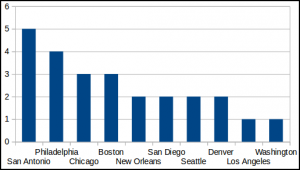This article is more than 5 years old.

I’ve done so much travel recently, I must be just about as developed as Charles Atlas, but only professionally developed, which looks a little different on the outside. I’ll summarize, as each of these meetings had one or two “price of admission” moments.
I’ve also had oddly charmed weather karma, as noted below.
LITA Forum, November in Minneapolis
Light jacket weather.
LITA had one of its best forums in years, and it was great to see good attendance for such good programs. [The 2016 Forum will be great also and you should all come! Its secret location will be revealed Real Soon Now.]
There were two sessions in particular I wanted to highlight. One of the keynotes was from Mark Matienzo, Director of Technology at the Digital Public Library of America. No one quite knew what was coming, but his talk, To Hell With Good Intentions: Linked Data, Community, and the Power to Name was a surprising and eye-opening look at social just aspects of metadata. I’d rather not even try to summarize—the session was recorded and will be posted within a week or two—but just to describe the major theme: The act of naming something has a power dynamic which, through maliciousness, ignorance, or indifference, can have a harmful effect on the people being named. This includes naming conventions like call numbers, controlled vocabularies, and authority files. I really invite you to watch this one when the LITA office can get it posted (they’re incredibly busy people).
The hands-down funniest session I can remember at any meeting was Does Anyone Even Click on That? by Bill Dueber from the University of Michigan. Aside from being outrageous and a little in-your-face—and energizing—it talked about some important points. Our capacity to do software development, web design, and UX studies (and bug fixes) is always a bottleneck in developing library services. Bill talked about assessment-based analysis of development priorities so that you can eventually say, “We’re going to fix problems A, B, and C, but problem D would take up more resources than it’s worth, so we’re just not going to fix it.” It’s an eye-opening response to a problem that otherwise just piles more and more to-do items on top of overworked tech staff.
CNI, Washington in December
Shirtsleeves and lunch outside.
This meeting has just plain outgrown its schedule, and there’s no way to see everything you’d like in the 26 hours from start to finish. Tim P. has posted about it. I’ll just say that he wanted to take in as much as he could about space planning and I wanted to hit the sessions on public and collaborative tech. We kept sitting together because there was a distinct theme of “space planning for public collaboration spaces.”
Aside from that, the winner for me was a session titles How Much Does $17 Billion Buy? Four presenters from UCLA tackled this question: journal publishers ask us to pay for published versions of an article even when open access pre-prints are freely available. Ostensibly, we should do this because the journal’s professional publishing staff add value to the final version in the form of proofreading, graphics, citation checking, etc, and this value is worth the subscription cost. So, does that hold true?
No.
This early report on research compared over a million articles by University of California authors that appear in both the OA physics repository arXiv.org and in commercial journals. Many details on how to do the harvesting, matching, and text comparison (fun for coding geeks). The big takeaway is that there is very little difference between the OA and published version of most of these articles.
However, there’s some sample bias here, that the researcher acknowledge and are working to correct. 96% of the articles they could retrieve from commercial publishers came from just one (Elsevier), and a disproportionate number of those came from one journal, Physics Letters B. This journal’s purpose is rapid turnaround of current research reports, so they emphasize speed over meticulous proof reading.
But still. If you’re paying a gazillion dollars for journals (or $17B for the University of California system), having essentially identical versions available for free might make you think about alternatives.
ALA Midwinter, Boston in January
One day of heavy rain and wind, but mostly unseasonably mild.
A little rummaging around in the twin disorders of my memory and ALA’s web site turns up this fact: this was my 25th Midwinter. From sea to shining sea, from the sun of San Antonio and San Diego to the day-long twilight of winter in Seattle, to some really impressive blizzards, and the fun of re-routing around earthquake damaged buildings and highways in L.A.
As with the last couple of ALA meetings, I got to attend very little in the way of programming, with the exception of Top Tech Trends, which others have covered. Just remember, even though the conference published the hash tag [https://twitter.com/hashtag/alattt]#alattt, this event comes from the good people of LITA.
Other than that…meetings. Eight hours on information policy, two hours on running effective meetings, a committee of committee chairs, and a committee of divisional presidents. And the five and a half hours of LITA Board meetings I presided over. And yet it all seemed like a very productive conference (okay, maybe the information policy meeting didn’t need the whole eight hours).

4 Comments on ‘Thomas – Hither and Yon’
If not for you, it would have been a SIX hours of board meetings. I’m looking forward to a “Name that Tune” approach (I can name that tune in 3 notes) to LITA board meetings…..”I can conclude that business in just 4 hours.” “I can do it in 3.5.”
Great job distilling the lessons of these conferences! I will definitely look out for Mark Matienzo’s talk, it sounds disruptive-in-a-good-way to the way we approach description as a field.
As you saw at CNI, I also saw at ALAMW an increasing attention to “space” and how technology might make us more aware of it or make the space more valuable for our users. This is a nice synthesis of an awful lot of travel and professional development. Thanks!
Love the weather karma reporting!
I want to know more about the UC study of OA vs. published versions. I’ve suspected as much for a long time, and faculty usually agree that little gets changed, but actual studies (even admittedly biased) will be helpful. And $17 BILLION for journals? Holy moly!